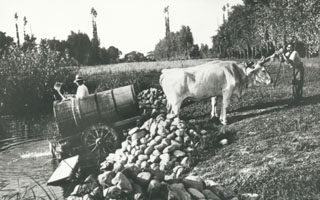Planting and upkeep of the vines

Ditches for the springtime planning of trees and vines were prepared in the autumn (fèr la fòsa) using spades, picks and shovels. A straight line was maintained with the help of a string (naspa, fil) to trace out the ditch. Trees, usually three-year old elms, were planted every 3.80 meters, the distance corresponding to the Bolognese unit of measure la pertica. In the space between each tree, two or four types of shoots of vines (taiól) were fastened to the ground with a trivet (truvèla). The resulting piantata was hoed in May and again in August for several years. In the third year the vines were cut back and, in the fourth, new shoots were directed along the main branches of the trees which had been pruned to form a Y-shape (cavàz). Between the eighth and tenth years, when the vines began to bear fruit and the elms began to yield wood, the branches (bindèna, tirèla) were extended laterally from the bifurcation of one tree to the trunks of the neighboring ones. The vines were positioned in one of two designs, either parallel to the ground (a pèr) or in diamond-shaped forms (a mandla).
Once the rows were formed, the men pruned them annually or biannually using long, straight ladders (schèla drétta) and tools such as the billhook (runcatta, rònca), scythe (falzòn), handsaw (ranzinèla) and, later, spring-loaded scissors (fórbs da vid).
The timber produced by the piantata was fastened in bundles (fas ed cavàz, fas ed vid) and divided between the tenant farmer and the landowner. It was used for heating, baking bread and cooking food. Any leftover timber was sold. The trees began to lose their leaves (fèr le fóia) annually about twenty years after planting. Women known as sfuiaróli collected fallen leaves during the final weeks of summer to use as livestock feed.
From the mid-1800s on, farmers sprayed the vines with a solution of copper sulfate (vairdràm), water and lime to combat late blight, a parasite fungus. The solution was applied with a pump, carried either in a backpack (pòmpa a spala) or in a cart. Sulfur powder (sòulfna), was sprayed on the plants when humid with a bellow duster (supiàtt) to protect the grape bunches from powdery mildew.